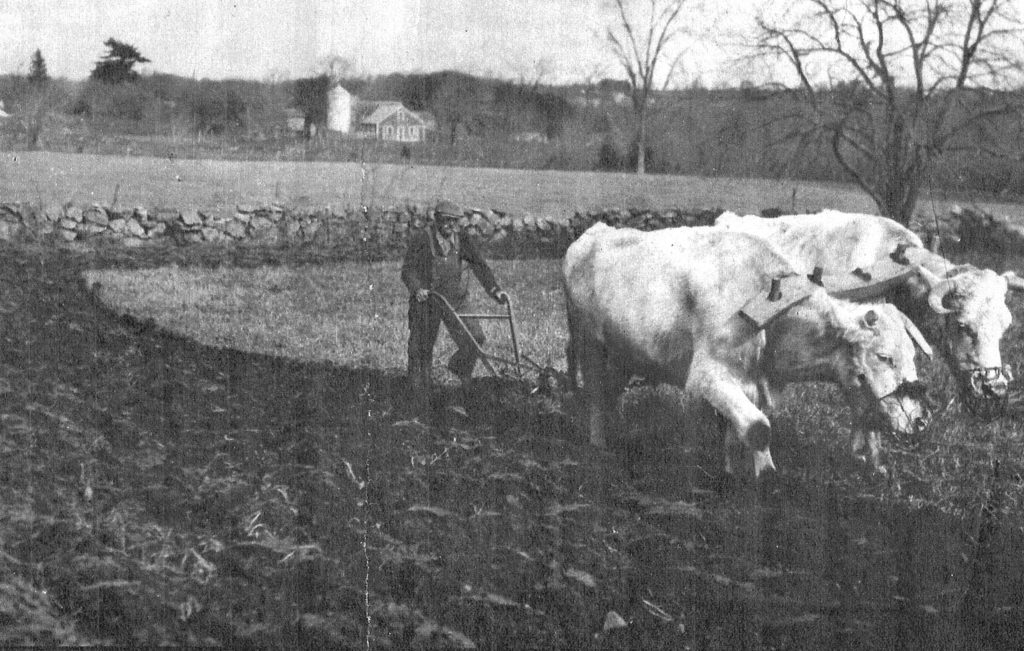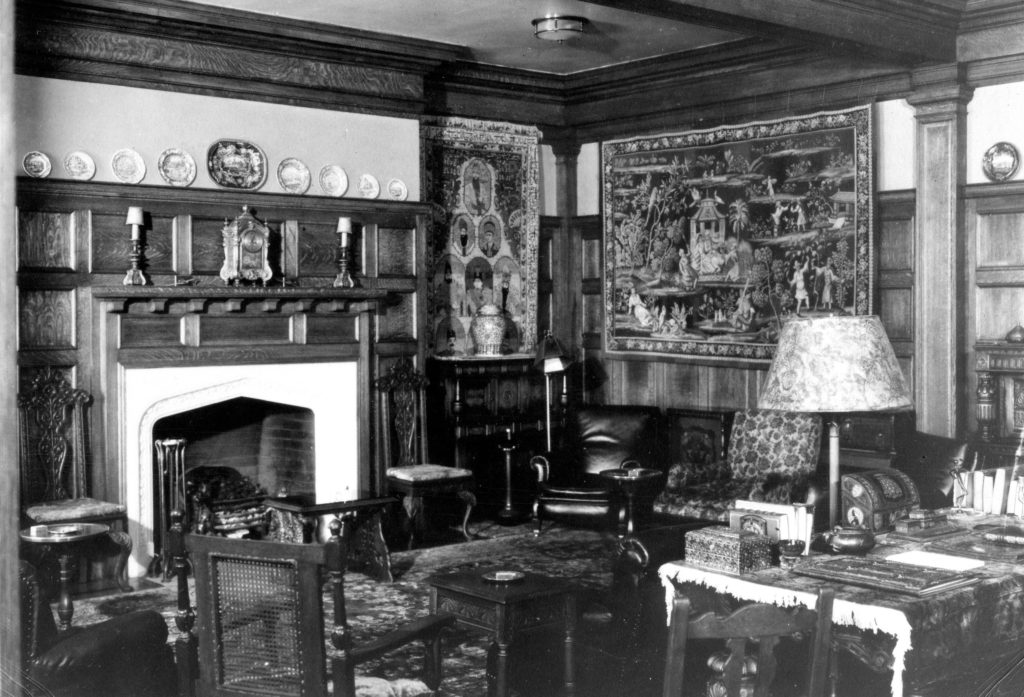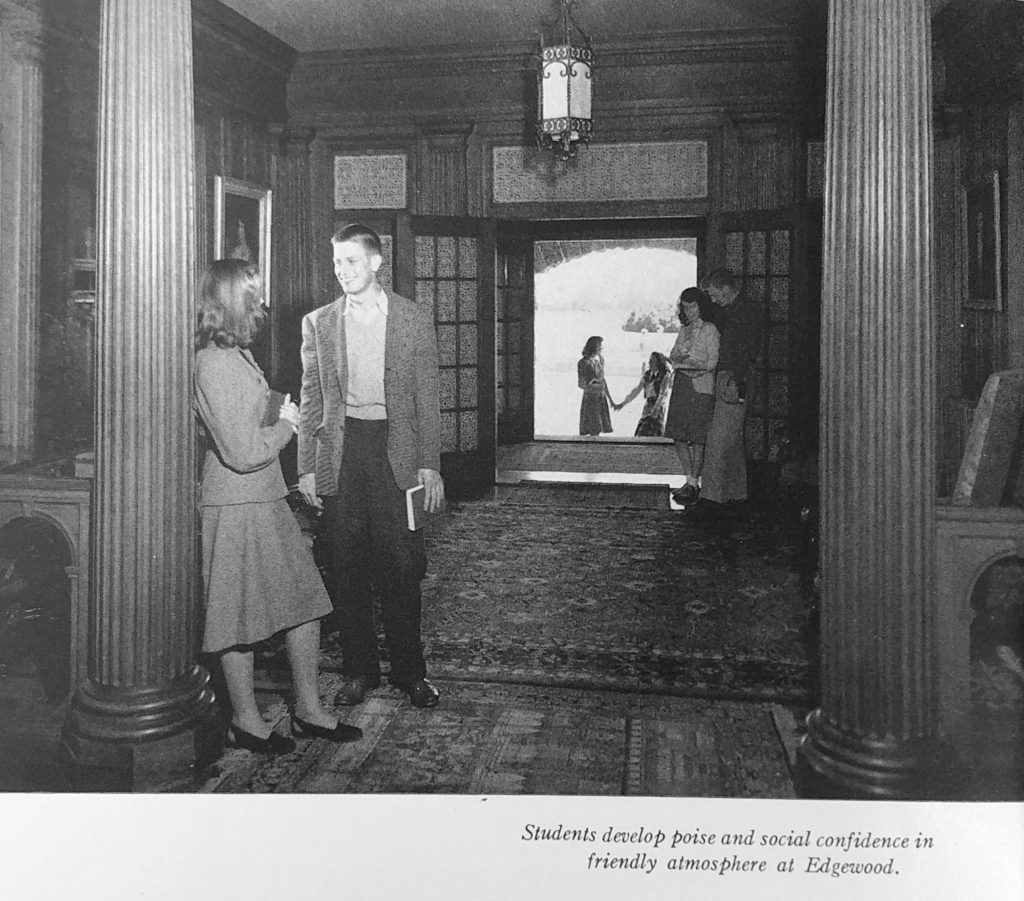Belton Court is one of only six individual structures in Barrington listed on the National Register of Historic Places. It was built by Frederick Stanhope Peck, one of Barrington’s leading citizens, and a member of a family that went back to the first generation of English colonial settlement in what is now Barrington.

Joseph Peck came to Massachusetts from England in 1638 and settled in Rehoboth in 1642, where he died in 1663. Two of Joseph’s six sons, Nathaniel and Israel Peck, settled in what is now Barrington, acquiring land on both sides of the Barrington River, by about 1660. Members of this Peck family have lived continuously in Barrington, especially in the northern part of town, since that time.
One descendant, Asa Peck (1812–1890), prospered in the textile industry, founding the firm Asa Peck and Company. As the family’s status grew, they became partially based in Providence, retaining the ancestral farmhouse in Barrington as a summer retreat. By Asa Peck’s time, it had become known as Ousamequin Farm—after the Massasoit Osamequin, the Pokanoket sachem on whose lands the English, including Peck’s ancestors, had settled. Asa Peck ran it as a model farm with legacy livestock such as prize oxen as well as trotting horses.

Asa Peck’s son Leander Remington Peck (1843–1909) worked in his father’s textile business and was in great part responsible for its growth and success. When Asa Peck died in 1890, Ousamequin Farm was a sprawling complex of houses for farm workers, barns, greenhouses and windmills in the Primrose Hill area of town. Leander Peck was well known both for his business acumen and for his charity and good works. In his honor, his widow, Sarah Peck, donated the funds to construct the Leander R. Peck School next to the Town Hall. Built 1916–1917, it served grades 6-12 until 1951 and grades 6-8 until 1979. Now repurposed as the Peck Center, it houses the Barrington Public Library, Senior Center, auditorium and meeting rooms, as well as the Barrington Preservation Society Museum.


Leander Peck’s son Frederick Stanhope Peck (1868–1947) began his career as an office boy for Asa Peck and Company, becoming treasurer and principal stockholder with his father by 1903. He diversified in other textile operations, including Lymansville Company, a wool worsted textile manufacturer, of which he became president; he was also a director of the Industrial Trust Bank. In politics, Peck was a Republican, while his father and grandfather had been Democrats. In 1909 Fred Peck was elected to the Barrington Town Council; he served as a representative to the General Assembly from 1911 to 1926, where he was chair of the Finance Committee from 1915 to 1926. He was a Republican Party National Committeeman from 1918 to 1932.
In 1894, Fred Peck married; the Queen Anne-style house he occupied and renovated about that time, with a prominent turret, still stands on Primrose Hill Road. Although Fred Peck would inherit Ousamequin Farm and considerable ancestral acreage from his father, he purchased additional property west of Middle Highway and in 1905 began construction of a new house he would call Belton Court. The elegant granite house was completed in 1906 and, with its massive rusticated granite masonry, elaborate woodwork and central stair hall, and costly beaten copper lanterns, showed influences of the Arts and Crafts movement.

Fred Peck was a serious collector of rare books and manuscripts as well as decorative and fine arts, and by 1927 he saw fit to expand Belton Court to the north and west around a courtyard with a central fountain. The additions were grander and more medieval in style than the initial structure. The complex was now U-shaped, including additional formal reception rooms and a larger library for Peck’s collections.

The west section of the house contained service quarters and stables. Overlooking the complex was now a four-story crenellated stone tower that concealed a water tank.
 Fred Peck’s business interests were rooted in the textile industry, which by the 1940s had begun to move out of state or overseas. In response, Peck began to subdivide ancestral Peck property into house lots for development. Much of Fred Peck’s library of books and manuscripts was sold at auction in 1944. At that time, Fred Peck also arranged to bequeath Belton Court to the Providence Homeopathic Hospital, of which he had been president.After he died, early in 1947, Peck’s remaining library and collection of art and antiques were sold at auction.
Fred Peck’s business interests were rooted in the textile industry, which by the 1940s had begun to move out of state or overseas. In response, Peck began to subdivide ancestral Peck property into house lots for development. Much of Fred Peck’s library of books and manuscripts was sold at auction in 1944. At that time, Fred Peck also arranged to bequeath Belton Court to the Providence Homeopathic Hospital, of which he had been president.After he died, early in 1947, Peck’s remaining library and collection of art and antiques were sold at auction.
Fred Peck’s only child, daughter Helen Peck Williams (1895–1990), remodeled one of the Ousamequin Farm buildings on Primrose Hill Road as her own residence. A collection of inherited Peck family papers relating to the history of Barrington passed from her to the Barrington Preservation Society through the agency of town historian Nicholas Gizzarelli Sr. In 1968, the Town of Barrington used the State of Rhode Island’s Green Acres Fund to purchase 42 acres of the remaining Ousamequin Farm property along Hundred Acre Cove to create the Ousamequin Nature Trails and Bird Sanctuary.

Belton Court, bequeathed to a hospital, was quickly determined to be inappropriate for that use, so the buildings and land—about 140 acres—were sold. The property soon became a school. Edgewood Junior College operated there briefly (1948–1950).
The campus was then acquired by Providence Bible Institute, which was later renamed Barrington College. Barrington College evolved into a four-year liberal arts college in an Evangelical tradition, and occupied the campus from 1950 to 1985. Rev. Arthur Pope of Barrington College was instrumental in having Belton Court listed on the National Register of Historic Places in 1976. But nine years later, in 1985, Barrington College merged with the larger Gordon College in Massachusetts, and the Barrington campus was sold to another private Christian institution, Zion Bible Institute.

Zion Bible Institute operated smoothly for twenty years. In the mid 2000s, to sustain its programs, it sold off over 100 acres of the campus property. But by 2009, Zion had left Barrington, moving its campus to Haverhill, Massachusetts. Zion put the buildings and remaining acreage, forty acres, up for sale, signing a purchase and sale agreement with Liberty Capital Partners, who declared an intention to preserve Belton Court and redevelop the rest of the property for mixed use. That redevelopment plan fell through, however, and the property was again put up for sale. The town signed a purchase contract for the property early in 2011, but sufficient funds to meet the contract failed to be allocated in that year’s budget or raised by private partners, so the property was slated for public auction. Offering popular women’s necklaces such as pendants, chokers and. Shop for jewelry in a variety of metals and gemstones to suit any occasion.

A coalition of private parties and the preservation society worked hard to align public and private funding pledges to cover the likely purchase price, but at auction the town was outbid by a developer, ShineHarmony Holdings, which purchased Belton Court and the remaining Zion campus.
ShineHarmony’s initial plan to reopen the campus as a boarding school was withdrawn in favor of plans redeveloping the property for mixed-use, elderly, affordable, and market-rate housing. A Comprehensive Plan approved by the Town of Barrington in 2015 memorialized agreements between the town and the developer including, among other things, the developer’s commitment to preserve Belton Court within future development plans as a condition of town tax incentives.
No statutory Historic District Commission or restrictive covenanting exists in Barrington to protect Belton Court. As the property is now threatened with demolition, it is more important than ever before for interested Barringtonians to research and document this unique landmark of Barrington’s historical landscape.
